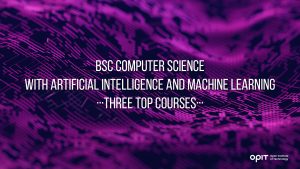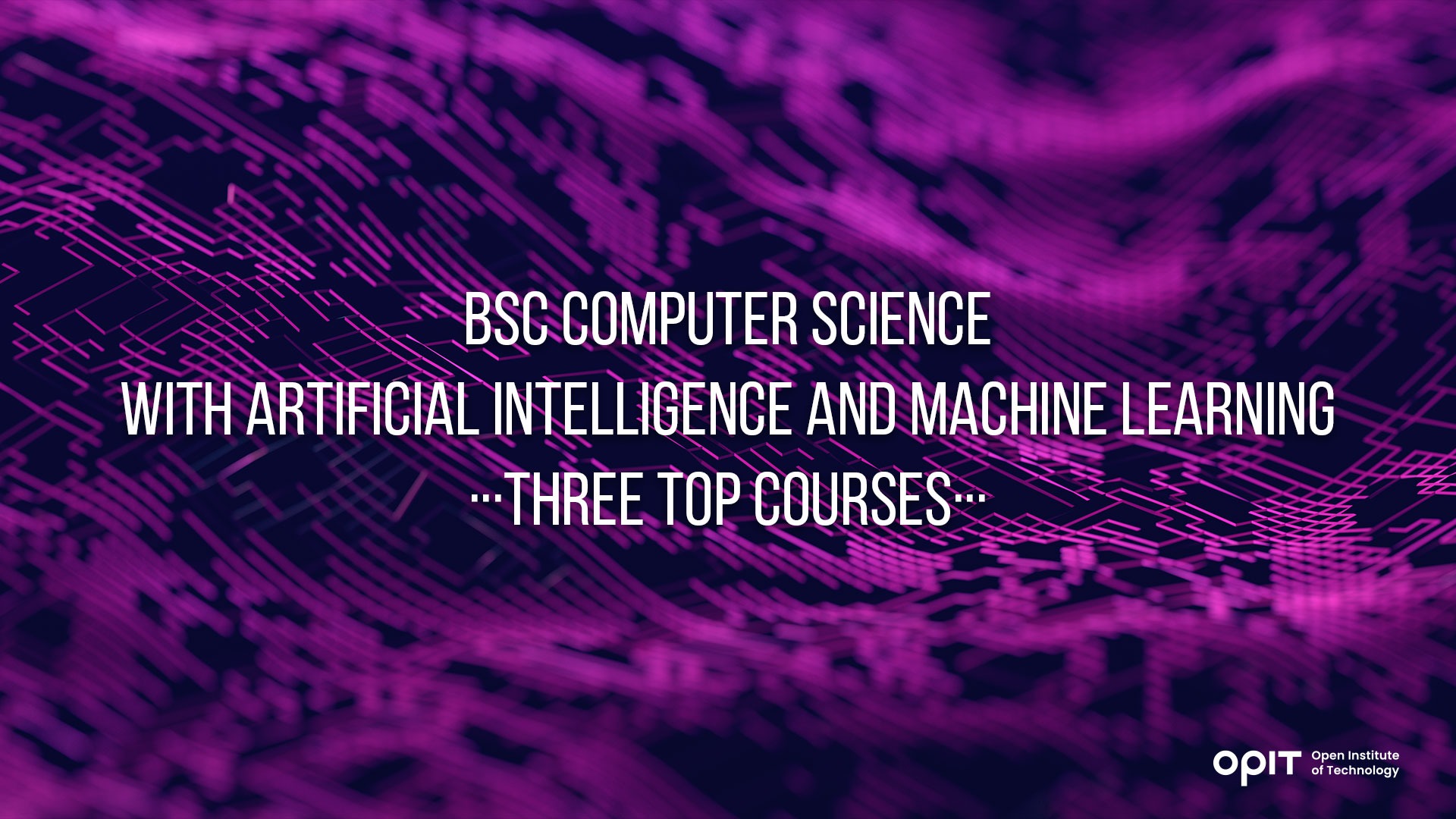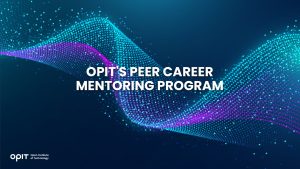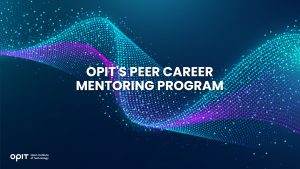Top Three Courses in BSc Computer Science With Artificial Intelligence and Machine Learning


AI is already a massive industry – valued at $136.55 billion (approx. €124.82 billion) as of 2022 – and it’s only going to get bigger as we come to grips with what AI can do. As a student, you stand on the cusp of the AI tidal wave and you have an opportunity to ride that wave into a decades-long career.
But you need a starting point for that career – a BSc computer science with artificial intelligence. The three courses discussed in this article are the best for budding AI masters.
Factors to Consider When Choosing a BSc Computer Science With AI Program
Before choosing your BSc, you need to know what to look for in a good course:
- Institution Accreditation – Whoever provides the course should offer solid accreditation so that you know you can trust the institution and that potential future employers actually respect the qualification you have on your VC.
- An AI-Focused Curriculum – Not all computer science bachelor’s degrees are the same. The one you choose needs to offer a specific focus on AI or machine learning so you can build the foundations for later specialization.
- Faculty Expertise – A course led by instructors who don’t know much about AI is like the blind leading the blind. Every mentor, instructor, and lecturer needs to have provable knowledge and industry experience.
- Job Opportunities – Every chance you have to “get your hands dirty” with AI is going to look great on your CV. Look for courses that create pathways into internships and job programs. Associations with organizations like IBM are a great place to start.
- Financial Aid – It isn’t cheap to study a BSc artificial intelligence and machine learning. Degrees cost thousands of Euros per year (the average in Europe is about €3,000, though prices can go higher) so the availability of financial aid is a huge help.
Top BSc Computer Science With AI Programs
Studying from the best is how you become a leader in the AI field. The combination of expert tuition and the name recognition that comes from having a degree from one of the following institutions stands you in good stead for success in the AI industry. Here are the top three organizations (with degrees available to overseas students) in the world.
Course 1 – BSc Artificial Intelligence – The University of Edinburgh
Named as one of the top 10 AI courses in the world by Forbes, The University of Edinburgh’s offering has everything you need from a great BSc computer science with artificial intelligence. It’s a four-year full-time course that focuses on the applications of AI in the modern world, with students developing the skills to build intelligent systems capable of making human-like decisions. The course is taught by the university’s School of Informatics, led by National Robotarium academic co-lead Professor Helen Hastie.
The course starts simple, with the first year dedicated to learning the language of computers before the second year introduces students to software development and data science concepts. By the third year, you’ll be digging deep into machine learning and robotics. That year also comes with opportunities to study abroad.
As for career prospects, The University of Edinburgh has a Careers Service department that can put you in line for internships at multi-national businesses. Add to that the university’s huge alumni network (essentially a huge group of professionals willing to help students with their careers) and this is a course that offers a great route into the industry.
Course 2 – Artificial Intelligence Program – Carnegie Mellon University
Ranked as the top university in the world for AI courses by Edurank, Carnegie Mellon University is a tough nut to crack if you want to study its world-renowned program. You’ll face a ton of competition, as evidenced by the university’s 17% acceptance rate, and the program is directed by Reid Simmons. For those who don’t recognize the name, he’s been a frontrunner in leveraging AI for NASA and was the creator of the “Robotceptionist.”
As for the course, it blends foundational mathematical, statistical, and computer science concepts with a wide variety of AI modules. It’s robotics-focused (that’s no surprise given the director), though you’ll also learn how AI applies on a perceptive level. The use of AI in speech processing, search engines, and even photography are just some examples of the concepts this course teaches.
Carnegie Mellon takes an interesting approach to internships, as it offers both career and academic internships. Career internships are what you’d expect – placements with major companies where you get to put your skills into practice. An academic internship is different because you’ll be based in the university and will work alongside its faculty on research projects.
Course 3 – BSc in Artificial Intelligence and Decision Making – Massachusetts Institute of Technology (MIT)
It should come as no surprise that MIT makes it onto the list given the school’s engineering and tech focus. Like Carnegie Mellon’s AI course, it’s tough to get into the MIT course (only a 7% acceptance rate) but simply having MIT on your CV makes you attractive to employers.
The course takes in multiple foundational topics, such as programming in Python and introductions to machine learning algorithms, before moving into a robotics focus in its application modules. But it’s the opportunities for research that make this one stand out. MIT has departments dedicated to the use of AI in society, healthcare, communications, and speech processing, making this course ideal for those who wish to pursue a specialization.
Networking opportunities abound, too. MIT’s AI faculty has 92 members, all with different types of expertise, who can guide you on your path and potentially introduce you to career opportunities. Combine that with the fact you’ll be working with some of the world’s best and brightest and you have a course that’s built for your success in the AI industry.
Emerging BSc Computer Science With AI programs
Given that AI is clearly going to be enormously important to developing industry in the coming years, it’s no surprise that many institutions are creating their own BSc computer science with artificial intelligence courses. In the UK alone, the likes of Queen’s University Belfast and Cardiff University are quickly catching up to The University of Edinburgh, especially in the robotics field.
In North America, the University of Toronto is making waves with a course that’s ranked the best in Canada and fifth in North America by EduRank. Interestingly, that course is a little easier to get into than many comparable North American courses, given its 43% acceptance rate.
Back in the UK, the University of Oxford is also doing well with AI, though its current courses tend to be shorter and specialized in areas like utilizing AI in business. We’re also seeing Asian universities make great progress with their courses, as both Tsinghua University and Nanyang Technological University are establishing themselves as leaders in the space.
Importance of Hands-On Experience and Internships
As important as foundational and theoretical knowledge is, it’s when you get hands-on that you start to understand how much of an impact AI will have on business and society at large. Good universities recognize this and offer hands-on experience (either via research or internship programs) that offer three core benefits:
- Gain Practical Skills – Becoming a walking encyclopedia for the theory of AI is great if you intend on becoming a teacher. But for everybody else, working with hands-on practical experiments and examples is required to develop the practical skills that employers seek.
- Networking – A strong faculty (ideally with industry as well as academic connections) will take you a long way in your BSc computer science with artificial intelligence. The more people you encounter, the more connections you build and the better your prospects are when you complete your course.
- Enhanced Job Prospects – Getting hands-on with real-world examples, and having evidence of that work, shows employers that you know how to use the knowledge you have knocking around your head. The more practical a course gets, the better it enhances your job prospects.
Scholarships and Financial Aid Opportunities
Due to BSc artificial intelligence and machine learning courses being so expensive (remember – an average of €3,000 per year), financial aid is going to be important for many students. In the UK, that aid often comes in the form of student loans, which you don’t have to start repaying until you hit a certain earnings threshold.
When we take things Europe-wide, more scholarship and financial aid programs become available. The Erasmus program offers funding for master’s students (assuming they meet the criteria) and there are several scholarship portals, such as EURAXESS and Scholarshipportal designed to help with financial aid.
If this is something you’re interested in, the following tips may help you obtain funding:
- Excel academically in pre-university studies to demonstrate your potential
- Speak to the finance teams at your university of choice to see what’s currently available
- Apply for as many scholarship and aid programs as you can to boost your chances of success
Try the Top BSc Artificial Intelligence and Machine Learning Programs
The three BSc computer science with artificial intelligence programs discussed in this article are among the best in the world for many reasons. They combine intelligence course focuses with faculty who not only know how to teach AI but have practical experience that helps you learn and can serve useful networking purposes.
The latter will prove increasingly important as the AI industry grows and becomes more competitive. But as with any form of education, your own needs are paramount. Choose the best course for your needs (whether it’s one from this list or an online BSc) and focus your efforts on becoming the best you can be.
Related posts

Source:
- Raconteur, published on November 06th, 2025
Many firms have conducted successful Artificial Intelligence (AI) pilot projects, but scaling them across departments and workflows remains a challenge. Inference costs, data silos, talent gaps and poor alignment with business strategy are just some of the issues that leave organisations trapped in pilot purgatory. This inability to scale successful experiments means AI’s potential for improving enterprise efficiency, decision-making and innovation isn’t fully realised. So what’s the solution?
Although it’s not a magic bullet, an AI operating model is really the foundation for scaling pilot projects up to enterprise-wide deployments. Essentially it’s a structured framework that defines how the organisation develops, deploys and governs AI. By bringing together infrastructure, data, people, and governance in a flexible and secure way, it ensures that AI delivers value at scale while remaining ethical and compliant.
“A successful AI proof-of-concept is like building a single race car that can go fast,” says Professor Yu Xiong, chair of business analytics at the UK-based Surrey Business School. “An efficient AI technology operations model, however, is the entire system – the processes, tools, and team structures – for continuously manufacturing, maintaining, and safely operating an entire fleet of cars.”
But while the importance of this framework is clear, how should enterprises establish and embed it?
“It begins with a clear strategy that defines objectives, desired outcomes, and measurable success criteria, such as model performance, bias detection, and regulatory compliance metrics,” says Professor Azadeh Haratiannezhadi, co-founder of generative AI company Taktify and professor of generative AI in cybersecurity at OPIT – the Open Institute of Technology.
Platforms, tools and MLOps pipelines that enable models to be deployed, monitored and scaled in a safe and efficient way are also essential in practical terms.
“Tools and infrastructure must also be selected with transparency, cost, and governance in mind,” says Efrain Ruh, continental chief technology officer for Europe at Digitate. “Crucially, organisations need to continuously monitor the evolving AI landscape and adapt their models to new capabilities and market offerings.”
An open approach
The most effective AI operating models are also founded on openness, interoperability and modularity. Open source platforms and tools provide greater control over data, deployment environments and costs, for example. These characteristics can help enterprises to avoid vendor lock-in, successfully align AI to business culture and values, and embed it safely into cross-department workflows.
“Modularity and platformisation…avoids building isolated ‘silos’ for each project,” explains professor Xiong. “Instead, it provides a shared, reusable ‘AI platform’ that integrates toolchains for data preparation, model training, deployment, monitoring, and retraining. This drastically improves efficiency and reduces the cost of redundant work.”
A strong data strategy is equally vital for ensuring high-quality performance and reducing bias. Ideally, the AI operating model should be cloud and LLM agnostic too.
“This allows organisations to coordinate and orchestrate AI agents from various sources, whether that’s internal or 3rd party,” says Babak Hodjat, global chief technology officer of AI at Cognizant. “The interoperability also means businesses can adopt an agile iterative process for AI projects that is guided by measuring efficiency, productivity, and quality gains, while guaranteeing trust and safety are built into all elements of design and implementation.”
A robust AI operating model should feature clear objectives for compliance, security and data privacy, as well as accountability structures. Richard Corbridge, chief information officer of Segro, advises organisations to: “Start small with well-scoped pilots that solve real pain points, then bake in repeatable patterns, data contracts, test harnesses, explainability checks and rollback plans, so learning can be scaled without multiplying risk. If you don’t codify how models are approved, deployed, monitored and retired, you won’t get past pilot purgatory.”
Of course, technology alone can’t drive successful AI adoption at scale: the right skills and culture are also essential for embedding AI across the enterprise.
“Multidisciplinary teams that combine technical expertise in AI, security, and governance with deep business knowledge create a foundation for sustainable adoption,” says Professor Haratiannezhadi. “Ongoing training ensures staff acquire advanced AI skills while understanding associated risks and responsibilities.”
Ultimately, an AI operating model is the playbook that enables an enterprise to use AI responsibly and effectively at scale. By drawing together governance, technological infrastructure, cultural change and open collaboration, it supports the shift from isolated experiments to the kind of sustainable AI capability that can drive competitive advantage.
In other words, it’s the foundation for turning ambition into reality, and finally escaping pilot purgatory for good.

The Open Institute of Technology (OPIT) is the perfect place for those looking to master the core skills and gain the fundamental knowledge they need to enter the exciting and dynamic environment of the tech industry. While OPIT’s various degrees and courses unlock the doors to numerous careers, students may not know exactly which line of work they wish to enter, or how, exactly, to take the next steps.
That’s why, as well as providing exceptional online education in fields like Responsible AI, Computer Science, and Digital Business, OPIT also offers an array of career-related services, like the Peer Career Mentoring Program. Designed to provide the expert advice and support students need, this program helps students and alumni gain inspiration and insight to map out their future careers.
Introducing the OPIT Peer Career Mentoring Program
As the name implies, OPIT’s Peer Career Mentoring Program is about connecting students and alumni with experienced peers to provide insights, guidance, and mentorship and support their next steps on both a personal and professional level.
It provides a highly supportive and empowering space in which current and former learners can receive career-related advice and guidance, harnessing the rich and varied experiences of the OPIT community to accelerate growth and development.
Meet the Mentors
Plenty of experienced, expert mentors have already signed up to play their part in the Peer Career Mentoring Program at OPIT. They include managers, analysts, researchers, and more, all ready and eager to share the benefits of their experience and their unique perspectives on the tech industry, careers in tech, and the educational experience at OPIT.
Examples include:
- Marco Lorenzi: Having graduated from the MSc in Applied Data Science and AI program at OPIT, Marco has since progressed to a role as a Prompt Engineer at RWS Group and is passionate about supporting younger learners as they take their first steps into the workforce or seek career evolution.
- Antonio Amendolagine: Antonio graduated from the OPIT MSc in Applied Data Science and AI and currently works as a Product Marketing and CRM Manager with MER MEC SpA, focusing on international B2B businesses. Like other mentors in the program, he enjoys helping students feel more confident about achieving their future aims.
- Asya Mantovani: Asya took the MSc in Responsible AI program at OPIT before taking the next steps in her career as a Software Engineer with Accenture, one of the largest IT companies in the world, and a trusted partner of the institute. With a firm belief in knowledge-sharing and mutual support, she’s eager to help students progress and succeed.
The Value of the Peer Mentoring Program
The OPIT Peer Career Mentoring Program is an invaluable source of support, inspiration, motivation, and guidance for the many students and graduates of OPIT who feel the need for a helping hand or guiding light to help them find the way or make the right decisions moving forward. It’s a program built around the sharing of wisdom, skills, and insights, designed to empower all who take part.
Every student is different. Some have very clear, fixed, and firm objectives in mind for their futures. Others may have a slightly more vague outline of where they want to go and what they want to do. Others live more in the moment, focusing purely on the here and now, but not thinking too far ahead. All of these different types of people may need guidance and support from time to time, and peer mentoring provides that.
This program is also just one of many ways in which OPIT bridges the gaps between learners around the world, creating a whole community of students and educators, linked together by their shared passions for technology and development. So, even though you may study remotely at OPIT, you never need to feel alone or isolated from your peers.
Additional Career Services Offered by OPIT
The Peer Career Mentoring Program is just one part of the larger array of career services that students enjoy at the Open Institute of Technology.
- Career Coaching and Support: Students can schedule one-to-one sessions with the institute’s experts to receive insightful feedback, flexibly customized to their exact needs and situation. They can request resume audits, hone their interview skills, and develop action plans for the future, all with the help of experienced, expert coaches.
- Resource Hub: Maybe you need help differentiating between various career paths, or seeing where your degree might take you. Or you need a bit of assistance in handling the challenges of the job-hunting process. Either way, the OPIT Resource Hub contains the in-depth guides you need to get ahead and gain practical skills to confidently move forward.
- Career Events: Regularly, OPIT hosts online career event sessions with industry experts and leaders as guest speakers about the topics that most interest today’s tech students and graduates. You can join workshops to sharpen your skills and become a better prospect in the job market, or just listen to the lessons and insights of the pros.
- Internship Opportunities: There are few better ways to begin your professional journey than an internship at a top-tier company. OPIT unlocks the doors to numerous internship roles with trusted institute partners, as well as additional professional and project opportunities where you can get hands-on work experience at a high level.
In addition to the above, OPIT also teams up with an array of leading organizations around the world, including some of the biggest names, including AWS, Accenture, and Hype. Through this network of trust, OPIT facilitates students’ steps into the world of work.
Start Your Study Journey Today
As well as the Peer Career Mentoring Program, OPIT provides numerous other exciting advantages for those who enroll, including progressive assessments, round-the-clock support, affordable rates, and a team of international professors from top universities with real-world experience in technology. In short, it’s the perfect place to push forward and get the knowledge you need to succeed.
So, if you’re eager to become a tech leader of tomorrow, learn more about OPIT today.
Have questions?
Visit our FAQ page or get in touch with us!
Write us at +39 335 576 0263
Get in touch at hello@opit.com
Talk to one of our Study Advisors
We are international
We can speak in:


